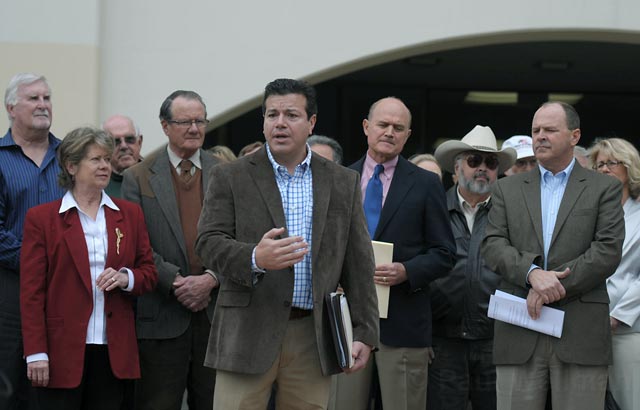Conservative Group Jabs Raw Nerve
Takes On Public Salaries and Pensions

Public employee pensions: Three words that are enough to make most people cringe, either because they don’t understand them, or because they do all too well.
With the state dealing with a $26-billion deficit, and Santa Barbara County looking at a budget shortfall of as much as $90 million, public employee salaries and benefits are coming under fire. Most recently, the Santa Barbara County Taxpayers Association (SBCTA) swarmed the steps of the County Administration Building on Monday, calling for union groups to sit down at the negotiating table with the county and forego wage increases recently implemented or just around the corner.
Many of the increases are coming to fruition after months — and in some cases more than a year — of deferral in order to help the county save money. But while those concessions and deferrals helped keep employees from getting laid off, the Taxpayers Association is calling for more. “We believe this is simply unsustainable,” said Joe Armendariz, SBCTA executive director. Former 3rd District supervisor Brooks Firestone agreed: “We are broke; California is broke; the county is broke.”
But for all the huffing Monday morning, union leaders responded with some puffing of their own, frowning upon the message of this week’s press conference and noting they have worked hard to save the county much-needed cash over the last few years as the economy tanked. SEIU, for example — which represents more than 2,000 service-level county employees — made concessions, including furloughs that saved the county more than $6.5 million in recent years. A 3.5-percent increase in salary implemented in January was negotiated in exchange for the concession. That’s two years of increased cost of living adjustments foregone, and SEIU is currently down 150 positions. “We’ve worked with this county and will continue to work with the county,” said Bruce Corsaw, SEIU Local 620 executive director, who stated they are preparing to begin negotiations with the county as their contract is up this June.
The Deputy Sheriffs’ Association (DSA), in exchange for the 3-percent-at-50 deal — meaning public safety officials can retire at age 50 with 3 percent of their final salary for every year they were employed — basically gave up four years of pay raises. Deferments have extended those lost raises even further. One 3-percent raise, supposed to go into effect last August, is set to be implemented with another planned 3-percent raise. Another increase is slated for August. Even with the 9-percent total jump, Johnson said, DSA members have actually gone down in pay because expenses went up while they received no cost-of-living adjustment. Only two members of the current board — 4th District Supervisor Joni Gray and 1st District Supervisor Salud Carbajal — sat on the board when the contract, which at the time was supported by the SBCTA, was negotiated.
While the raises were under particular scrutiny Monday, pension pay in general has put the county in a real bind. For a number of reasons — people are living longer in retirement and the rate of retirement has been going up, for example — the county’s pension obligations are reaching a breaking point.
But because of the market’s downturn, the Board of Retirement voted late last year to increase the county’s contribution rate. The county was paying nearly 29 cents into the retirement fund for every dollar of payroll, but when the valuation jumps, the county will be paying more than 37 cents on the dollar, an estimated $30-million increase.
With this in mind, a five-member advisory commission that formed last year — which included former SEIU Local 620 executive director Walt Hamilton and former county treasurer-tax collector Gary Feramisco — gave the Board of Supervisors recommendations on Tuesday on how to mitigate costs related to providing retirement benefits.
Because of state laws that protect current employees, pension-change options are limited. But future employees of the county could see a different setup in their benefit structure. Some of the recommendations include eliminating employer contributions to employees’ payments toward their pension benefit, implementing a 2-percent cost-of-living adjustment as opposed to the current 3 percent, no longer allowing employees to cash out unused vacation hours (which increases their final average salary), and eliminating all performance-based lump-sum payments. The last two would result in changes to an employee’s final average salary, which is used when pension benefits are calculated.
Additionally, the commission recommended switching to a 2-percent-at-50 formula for all safety employees, or a 2-percent-at-50 for Probation Department personnel, and 3-percent-at-55 for Fire and Sheriff’s Department employees. For future general employees, suggested alternatives were 1.62-percent-at-65 or 2-percent-at-61¼.
But what recommendations the supervisors actually implement will be decided in closed session during negotiations with union groups. Those negotiations are just starting up and are likely to continue through to the budget hearings in June. Regardless, hard choices will have to be made to bridge the gap, and cuts to services, salaries, and employees are all on the table.



